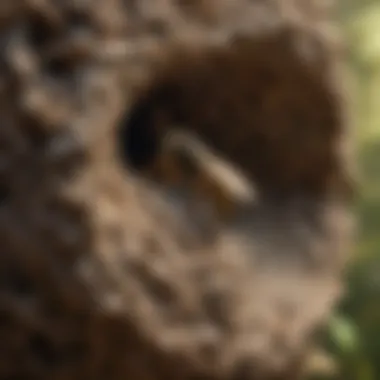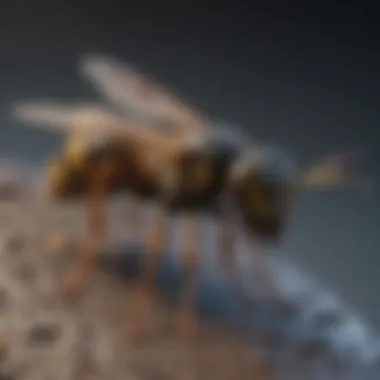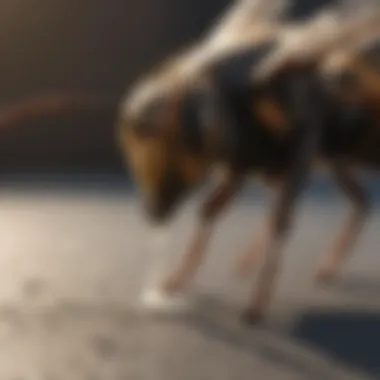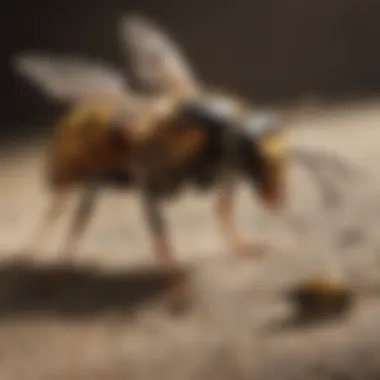Effective Methods for Instant Wasp Elimination


Intro
Wasp infestations can cause significant distress for homeowners. Understanding wasps, their behavior, and effective removal techniques is essential for dealing with these pests proactively. This article aims to provide practical insights into instant wasp elimination while emphasizing safety and efficiency.
Understanding the Pest
Effectively tackling wasp issues begins with gaining a clear understanding of the pest at hand. This section delves into the identification and life cycle of wasps.
Identification
Wasps vary in appearance, but they generally have slender bodies with a tapered waist. The common yellow jacket and paper wasp are two widespread species. Yellow jackets have yellow and black striped bodies with shiny exoskeletons, which can make them appear aggressive. In contrast, paper wasps tend to be darker with elongated bodies and are less likely to attack unless threatened. Recognizing these differences can help in determining the best removal strategy.
Life Cycle
An understanding of the wasp life cycle is crucial for controlling their populations. Wasps undergo complete metamorphosis, which includes four stages: egg, larva, pupa, and adult. In the spring, fertilized queens emerge from hibernation to build nests and lay eggs. As summer approaches, the colony grows rapidly, and workers are responsible for feeding the larvae and expanding the nest. By late summer or early fall, colonies can contain thousands of individuals. Knowing this cycle aids in timing your elimination efforts when wasps are most vulnerable.
Pest Prevention Strategies
Prevention is often the best method of controlling wasp populations. Few simple adjustments can significantly reduce the chances of wasps turning your home into their territory.
Environment Modification
Keeping your environment less hospitable to wasps is an effective strategy. Here are some modifications to consider:
- Remove fallen fruits from trees as they attract wasps.
- Seal garbage bins and compost piles tightly to prevent easy access to food sources.
- Keep outdoor eating areas tidy, disposing of food waste promptly.
Physical Barriers
Installing physical barriers can effectively deter wasps. Consider:
- Adding mesh screens to windows and vents to block entry points.
- Covering outdoor patios and decks with canopies to limit inviting nesting spots.
- Regularly inspecting your home for signs of nests, particularly in sheltered areas like eaves or attics, can prevent infestations.
Control Methods
When faced with an active wasp problem, various control methods are available to homeowners.
Chemical Control
Chemical solutions can provide swift results. Here are some notable products:
- Ortho Home Defense Insect Killer: A ready-to-use spray designed for immediate dispatching of wasps on contact.
- Raid Wasp and Hornet Killer: This spray offers a long-range application, ideal for keeping a safe distance while targeting nests.
Always follow the label directions for safety.
Biological Control
Biological control methods rely on introducing natural enemies of the wasps. A common alternative is the use of nematodes, which are microscopic roundworms that can target wasp larvae. This method can be slow but contributes to a balanced ecosystem without harmful chemicals.
Remember: Whichever control method you choose, safety should remain a priority. Always wear protective clothing and approach nests cautiously.
Prolusion to Wasp Control
Managing wasps is an essential aspect of maintaining a safe and comfortable living environment. Wasps can be a significant nuisance, especially during warmer months, as they become more active and are often attracted to food and sweet drinks. The importance of wasp management goes beyond mere comfort; it is also crucial for ensuring the safety of individuals, particularly those with allergies to stings. Understanding both the risks posed by wasps and effective control methods can empower homeowners to take action when necessary.
The Importance of Wasp Management
Wasp management is vital for several reasons. First, wasps can be aggressive, especially when they feel threatened or when their nest is disturbed. This aggressive behavior can lead to painful stings, which, for some people, may cause severe allergic reactions. Second, wasps play a role in the ecosystem, but their proximity to human activity can spark troubling interactions. Effectively managing their populations helps to reduce these interactions while also recognizing their ecological contributions.
Moreover, proactive wasp management leads to better prevention strategies. If homeowners are aware of wasp behavior and the signs of nests, they can act before a full infestation occurs. This foresight can save time, money, and potential harm. Therefore, understanding the need for wasp control is the first step toward ensuring a peaceful home environment.
Understanding Wasp Behavior


Knowing how wasps behave is crucial to applying effective control methods. Wasps are social insects that usually form nests in sheltered locations. Their nests can be found in trees, attics, and even under eaves. While some wasps build small nests, others can create large colonies quickly, leading to significant population increases over a short period.
Wasps are attracted to food sources, particularly sugary substances and proteins. Therefore, during the summer months, their presence can become more pronounced at barbecues or picnics, making it essential to keep food covered and waste secured. Additionally, understanding their foraging patterns can help inform the timing of any control methods being employed.
It's also worth noting that wasps are more active during certain parts of the day, often reaching peak activity in the afternoon. Awareness of these behavioral patterns can assist homeowners in establishing safe times to inspect their properties and check for nests without attracting unwanted attention. Agents employed to control wasps can be significantly more effective when the timing aligns with wasp activity.
Identifying Wasp Species
Recognizing the specific species of wasps is crucial in effective pest management. Different species exhibit distinct behaviors and habitat preferences. This knowledge allows for tailored elimination strategies. Understanding the characteristics of various wasps can lead to safer and more efficient control measures. By identifying them accurately, homeowners can avoid unnecessary panic and potentially harmful reactions to species that are not aggressive. Furthermore, recognizing beneficial wasps is vital; some help pollinate plants and control pest populations.
Common Wasp Species
Several species commonly invade residential areas. The German wasp and the common wasp are among the most prevalent in urban settings. These species often build nests in sheltered locations, such as eaves and attics.
- German Wasp: Yellow and black striped, aggressive when provoked. They tend to form large colonies.
- Common Wasp: Similar coloration but occurs in smaller numbers. They are less aggressive unless their nest is threatened.
- Yellow Jackets: Often confused with bees, these wasps are recognizable by their distinct yellow and black bands. They can be quite aggressive when food is nearby.
Recognizing these species helps in planning effective treatments that minimize risk to humans and pets.
Distinguishing Wasps from Bees
It is essential to differentiate between wasps and bees, as their roles in the ecosystem and behavior vary significantly.
Key Differences:
- Body Shape: Wasps typically possess a slimmer physique compared to the rounder, fuller bodies of bees.
- Hair: Wasps have less body hair than bees, giving them a shinier appearance.
- Nesting Behavior: Wasps build paper-like nests, while bees create wax structures.
- Behavior: Generally, wasps are more aggressive and don't maintain the same flower-foraging behaviors as bees.
Understanding these differences not only aids in proper handling but also reinforces the importance of preserving bees, which are vital for pollination.
"Identifying the right species of wasps can prevent unnecessary harm to beneficial insects in your garden."
With informed insight into various wasp species, homeowners can approach pest problems more strategically.
Chemical Methods of Wasp Elimination
Wasp elimination is often necessary for ensuring safety and comfort in areas where these insects become a nuisance. Chemical methods for wasp control provide an immediate solution for infestations. The effectiveness, speed, and targeted approach of chemical treatments make them crucial for both homeowners and pest control professionals. However, these methods should be used thoughtfully, considering both safety and environmental impact.
Overview of Chemical Solutions
Chemical solutions for wasp elimination are varied and can include sprays, baits, and insecticides designed specifically for wasp species. These solutions operate effectively by targeting the wasps' biology, quickly incapacitating them upon contact or ingestion. The choice of solution will depend on the level of infestation and the desired speed of resolution. Proper application and safety measures are essential elements of using chemical solutions effectively.
Types of Insecticides
There are several classes of insecticides available for wasp control, each with specific characteristics and applications. Understanding these is key to effective wasp elimination.
Pyrethroids
Pyrethroids are synthetic chemicals modeled after natural pyrethrins, found in chrysanthemum flowers. They work by disrupting normal nervous system function in insects, leading to paralysis and death. Their fast-acting nature makes them a popular choice for instant wasp elimination. The key characteristic of pyrethroids is their rapid knockdown effect, which can eliminate wasps almost immediately on contact. They also have a relatively low toxicity to mammals, making them a beneficial option for home use; however, over-reliance can lead to resistance in the target wasp populations.
Organophosphates
Organophosphates are a class of insecticides that interfere with the insect's nervous system. They are effective against various pests, including wasps. The key characteristic of organophosphates is their ability to provide a longer residual effect compared to some other chemicals. They are effective for broader pest control strategies, but safety measures are crucial due to higher toxicity levels, especially to non-target species. Caution is necessary when using organophosphates, particularly in residential areas where children and pets are present.
Neonicotinoids
Neonicotinoids are insecticides that mimic nicotine and act on the nervous system of insects. They offer significant efficacy against wasps and are often used in both sprays and baits. A defining feature of neonicotinoids is their systemic action; they can be absorbed by plants, thus affecting wasps that feed on them. This class of insecticides is seen as a modern solution with strong efficacy. However, concerns about their impact on pollinators and ecosystem health make it important to use them judiciously.
Application Techniques
How chemical solutions are applied can greatly influence their effectiveness and safety. Different methods can be utilized based on the products and the situation at hand.
Direct Spraying
Direct spraying involves applying insecticide directly onto the wasps or nests. This method provides immediate results. The key characteristic of direct spraying is its ability to quickly eliminate visible wasps. However, it requires careful aiming and timing since wasps can be agitated and may attack. It can be less effective against nests located in hard-to-reach places and often requires multiple applications.


Aerosol Can Use
Aerosol sprays are convenient for treating wasps in both outdoor and indoor settings. The key characteristic is their ease of use and ability to deliver chemicals in a directed spray. This method allows for a safe distance from potentially aggressive wasps. Aerosol cans are often readied for immediate use, making them a quick solution. However, they may have limitations in terms of coverage and residual effectiveness, depending on the formulation.
Powdered Insecticides
Powdered insecticides can be applied around the nest or on the insects directly. The key characteristic of powdered insecticides is that they adhere to wasps' bodies, which can lead to ingestion and elimination. They are suitable for use in more confined areas where sprays may not penetrate well. However, their effectiveness may require time and may not provide an instant result like other options.
To effectively manage wasps, a clear understanding of chemical options and application methods is essential.
Natural Solutions for Wasp Control
The use of natural solutions for wasp control is increasingly relevant, especially among homeowners who prefer eco-friendly methods. These solutions often prioritize safety, both for the environment and the individuals involved. Natural methods can also be less toxic than traditional chemical sprays. This section explores various natural strategies that can effectively repel or eliminate wasps. By emphasizing these alternatives, it can encourage sustainable living and reduce the reliance on chemical pesticides.
Essential Oils for Repelling Wasps
Essential oils are a popular choice for wasp repellent because they offer a non-toxic alternative to commercial solutions. Oils such as peppermint, eucalyptus, and clove are known for their strong scents. Wasps find these odors overwhelming and unpleasant. Thus, using essential oils can effectively deter them from entering your space. This method is simple and typically involves mixing a few drops of oil with water and spraying it around areas where wasps may be present. Regular application can help maintain its effectiveness.
Homemade Wasp Deterrents
Soap and Water Mixture
The soap and water mixture serves as a simple yet effective solution. This combination works by suffocating the wasps. When wasps come into contact with soapy water, it clogs their breathing pores, leading to their demise. The appeal of this method lies in its accessibility; most households have soap and water readily available. It's an inexpensive option and poses minimal harm to the environment. However, caution is necessary to ensure that the affected area is away from beneficial insects.
Vinegar Traps
Vinegar traps are another efficient natural deterrent. The acetic acid in vinegar attracts wasps, drawing them into a container where they can’t escape. This method is beneficial because it utilizes common household items, like apple cider vinegar and a jar. Setting up a vinegar trap is simple and does not require specialized skills. However, it must be placed strategically to increase effectiveness, often near garbage bins or flowering plants. While vinegar traps are effective, they do require regular maintenance, including emptying the traps when full.
Using Natural Predators
Introducing natural predators can be a long-term strategy for controlling wasp populations. Birds and certain insects are known to prey on wasps. Encouraging these natural predators in your garden can help maintain a balanced ecosystem. Install birdhouses or plant a diverse range of native plants that attract these species. While this method may take time to observe results, it contributes to the overall health of the environment.
"Natural wasp control solutions not only help mitigate infestations but also support ecological balance."
In summary, the effectiveness of natural solutions for wasp control lies in their simplicity and safety. Essential oils, homemade mixtures, and the use of natural predators present viable alternatives to traditional chemical methods. Adopting these practices can lead to a more sustainable approach to pest management.
Preventative Measures to Avoid Wasp Infestations
Preventing wasp infestations is an essential aspect of managing these pests effectively. It is known that a proactive approach is much more efficient than reactive measures. Understanding potential nesting sites, waste management practices, and sealing entry points can significantly reduce the chances of wasps establishing themselves in and around your property. The following sections will detail these methods.
Identifying Nesting Areas
Identifying and understanding potential nesting areas is crucial. Wasps prefer places that are sheltered and away from direct human activity. Common locations include eaves, attics, and under decks. Regular inspections of these areas can help homeowners spot signs of nests before they become a larger problem. When monitoring these regions, look for wasps flying in and out of specific areas. Remember, an early detection allows for timely intervention, which is less likely to provoke wasps.
- Common Nest Locations
- Eaves and gutters
- Attics
- Underside of decks and patios
Proper Waste Management
Waste management is a major aspect of wasp prevention. Wasps are attracted to food sources and sugary substances. Thus, maintaining cleanliness is vital. Secure bins and dispose of waste properly. This includes:
- Using tight-fitting lids on trash cans
- Keeping outdoor eating areas clean
- Promptly removing fallen fruit and other organic debris
Effective waste management reduces the likelihood of attracting wasps and can significantly lessen potential conflicts.
Sealing Entry Points
Sealing entry points in your home is another effective strategy. Wasps can enter through even the smallest of openings. Examine your property for any cracks or holes and seal them effectively. This includes:
- Checking windows and door frames for gaps
- Inspecting the foundation and walls for cracks
- Ensuring vents have proper screening


Taking these preventative measures creates a less hospitable environment for wasps, making it much harder for them to establish a colony.
In summary, preventative measures not only reduce the likelihood of wasp infestations but also foster a more enjoyable outdoor living environment for you and your family.
Safety Considerations When Dealing with Wasps
Dealing with wasps can be challenging and potentially dangerous. Understanding safety considerations when attempting wasp elimination is crucial. With their ability to sting, wasps can pose a threat, especially to those who are allergic. Therefore, awareness of personal safety and the use of proper techniques is essential.
Moreover, ineffective or reckless attempts at removal can lead to a swarm, increasing the risk of multiple stings. Thus, it is not just about effective elimination methods but also about ensuring a safe environment during the process. By prioritizing safety, individuals can reduce anxiety and regulate confrontational situations.
When to Call a Professional
There are certain situations where calling a professional pest control service is advisable. If the wasp nest is large or situated in a hard to reach area, such as under eaves or within walls, experts should handle the situation. They possess the right tools and experience to manage nests without endangering themselves or others.
People with known allergies to insect stings must be particularly cautious. It is safer for them to avoid personal confrontation with wasps. A single sting can prompt severe reactions, requiring immediate medical attention. Additionally, if wasps repeatedly invade specific areas, professionals can identify and address long-term solutions. Ultimately, if uncertainty exists regarding personal safety, it is best to seek professional help to avoid the risk of harm.
Protective Gear and Precautions
Using proper protective gear is vital when attempting to eliminate wasps. Recommended attire includes:
- Long-sleeved shirts and pants: This protects exposed skin from stings.
- Gloves: Wearing gloves minimizes contact with wasps and reduces sting risk.
- Face and eye protection: A veil or mask can shield the face from aggressive behaviors.
- Sturdy footwear: Closed-toe shoes can prevent stings to bare feet.
Before engaging with wasps, it is best to plan ahead. Take time to assess the area and determine the quickest route for escape if needed. Avoid wearing brightly colored clothing and scented lotions that may attract wasps.
Additionally, conducting elimination processes during dusk or dawn when wasps are less active can minimize risk. Being cautious and well-prepared provides protection and confidence.
Always prioritize your safety when dealing with wasps. It is more prudent to make a careful plan than to rush into potentially dangerous situations.
Legal and Environmental Implications
Understanding the legal and environmental aspects of wasp elimination is crucial for both homeowners and pest control professionals. Recognizing the implications surrounding this topic ensures that you not only adhere to local regulations but also maintain the ecological balance in your area. This section outlines essential elements concerning laws and environmental impact, ultimately guiding effective and responsible pest control practices.
Understanding Local Regulations
Regulations for wasp control vary by location. It's imperative to consult your local authorities or pest control agencies to understand what practices are permitted. In several areas, certain methods of wasp elimination may be restricted due to their environmental impact, especially concerning endangered species or protected ecosystems.
- Permits: Some jurisdictions may require a permit for specific insecticide use or the destruction of nests. Failing to obtain these can result in fines.
- Chemical Restrictions: Certain insecticides are banned or limited in use, especially those that are harmful to bees and other beneficial insects.
- Reporting Infestations: In case of significant infestations, you may need to report to local health departments to prevent potential public health risks.
Staying informed about these regulations is essential for effective and lawful pest management. Failure to comply may lead to legal issues and undermine the efforts of responsible homeowners aiming to maintain a safe living space.
Impact on Local Ecosystem
Wasp populations play an important role in the ecosystem, acting as both predators of pest insects and pollinators. Therefore, using overly aggressive or harmful elimination methods can disrupt local biodiversity. Here are some implications to consider:
- Predatory Role: Wasps help in controlling pest populations such as caterpillars and aphids. Their absence may lead to an increase in these pests, resulting in further issues for gardens and crops.
- Pollination: While bees are more commonly associated with pollination, wasps also contribute to this process. Their reduction could adversely affect flowering plants and crops.
- Biodiversity: Disproportionate removal of wasp species could upset the local food chain, impacting birds and other wildlife that rely on wasps as a food source.
Maintaining balance is key. Individuals should aim for methods that minimize harm, such as using targeted sprays or traps, rather than broad-application insecticides. A harmonious approach ensures not only effective wasp control but also the health of the surrounding environment.
By understanding legal and ecological implications, homeowners can pursue effective wasp control methods while fostering a healthier ecosystem.
Finale
The conclusion of this article serves a pivotal role in summarizing the vital points covered throughout the discussion about wasp elimination. Understanding and applying effective methods for instant wasp removal can significantly enhance safety and comfort for homeowners and their families. Whether facing chemical solutions or natural alternatives, the aim remains the same: minimize the risks posed by wasps while maintaining a balance with the ecosystem.
Summary of Key Points
We explored various techniques for wasp elimination, including:
- Chemical Methods: Different types of insecticides like pyrethroids, organophosphates, and neonicotinoids, along with their application techniques.
- Natural Solutions: The use of essential oils, homemade deterrents, and the employment of natural predators to combat wasp invasions.
- Preventative Measures: Identifying nesting areas and sealing entry points to reduce the likelihood of infestations.
- Safety Considerations: Recognizing when to engage professionals and utilizing proper protective gear in wasp removal activities.
- Legal and Environmental Considerations: Understanding local regulations regarding wasp control is essential to minimizing unintended ecological impacts.
This summary encapsulates the breadth of information provided, reinforcing the idea that effective wasp management requires vigilant preparation and diversified strategies.
Final Recommendations
For individuals or families looking to manage wasp issues, consider the following recommendations:
- Assess your Environment: Regularly check your property for signs of wasp nests and take action promptly.
- Choose Safely: When opting for chemical methods, select products with lower impacts on the environment and always follow application guidelines to ensure safety.
- Utilize Natural Techniques: Integrate natural deterrents into regular pest control routines. They can be effective and safer for the ecosystem.
- Educate Yourself: Keeping informed about wasp behavior and control methods will empower you to handle infestations more effectively.
- Consult Professionals: In persistent cases of wasp infestations, do not hesitate to seek help from pest control experts, especially if the nests are high or hard to reach.
By implementing these recommendations, homeowners can create safer living spaces while effectively addressing wasp-related issues.







